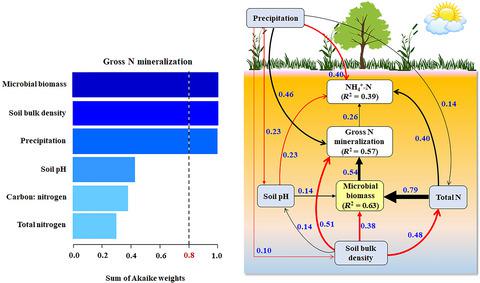当前位置:
X-MOL 学术
›
Glob. Change Biol.
›
论文详情
Our official English website, www.x-mol.net, welcomes your
feedback! (Note: you will need to create a separate account there.)
Patterns and drivers of global gross nitrogen mineralization in soils
Global Change Biology ( IF 10.8 ) Pub Date : 2021-08-18 , DOI: 10.1111/gcb.15851 Ahmed S Elrys 1, 2 , Ahmad Ali 1 , Huimin Zhang 1 , Yi Cheng 1, 3, 4 , Jinbo Zhang 1 , Zu-Cong Cai 1 , Christoph Müller 5, 6 , Scott X Chang 7, 8
Global Change Biology ( IF 10.8 ) Pub Date : 2021-08-18 , DOI: 10.1111/gcb.15851 Ahmed S Elrys 1, 2 , Ahmad Ali 1 , Huimin Zhang 1 , Yi Cheng 1, 3, 4 , Jinbo Zhang 1 , Zu-Cong Cai 1 , Christoph Müller 5, 6 , Scott X Chang 7, 8
Affiliation

|
Soil gross nitrogen (N) mineralization (GNM), a key microbial process in the global N cycle, is mainly controlled by climate and soil properties. This study provides for the first time a comprehensive analysis of the role of soil physicochemical properties and climate and their interactions with soil microbial biomass (MB) in controlling GNM globally. Through a meta-analysis of 970 observations from 337 published papers from various ecosystems, we found that GNM was positively correlated with MB, total carbon, total N and precipitation, and negatively correlated with bulk density (BD) and soil pH. Our multivariate analysis and structural equation modeling revealed that GNM is driven by MB and dominantly influenced by BD and precipitation. The higher total N accelerates GNM via increasing MB. The decrease in BD stimulates GNM via increasing total N and MB, whereas higher precipitation stimulates GNM via increasing total N. Moreover, the GNM varies with ecosystem type, being greater in forests and grasslands with high total carbon and MB contents and low BD and pH compared to croplands. The highest GNM was observed in tropical wet soils that receive high precipitation, which increases the supply of soil substrate (total N) to microbes. Our findings suggest that anthropogenic activities that affect soil microbial population size, BD, soil substrate availability, or soil pH may interact with changes in precipitation regime and land use to influence GNM, which may ultimately affect ecosystem productivity and N loss to the environment.
中文翻译:

全球土壤中总氮矿化的模式和驱动因素
土壤总氮(N)矿化(GNM)是全球氮循环中的关键微生物过程,主要受气候和土壤特性控制。本研究首次对土壤理化性质和气候的作用及其与土壤微生物生物量 (MB) 的相互作用在全球控制 GNM 中的作用进行了全面分析。通过对来自不同生态系统的 337 篇已发表论文的 970 条观察结果进行荟萃分析,我们发现 GNM 与 MB、总碳、总 N 和降水呈正相关,与容重 (BD) 和土壤 pH 呈负相关。我们的多变量分析和结构方程模型表明,GNM 受 MB 驱动,主要受 BD 和降水影响。较高的总 N 通过增加 MB 来加速 GNM。BD 的减少通过增加总 N 和 MB 刺激 GNM,而较高的降水通过增加总 N 刺激 GNM。 此外,GNM 因生态系统类型而异,在总碳和 MB 含量高、BD 和 pH 值低的森林和草地中更大与农田相比。在接收大量降水的热带潮湿土壤中观察到最高的 GNM,这增加了土壤基质(总氮)对微生物的供应。我们的研究结果表明,影响土壤微生物种群大小、BD、土壤基质可用性或土壤 pH 值的人为活动可能与降水状况和土地利用的变化相互作用,从而影响 GNM,最终可能影响生态系统生产力和 N 向环境的流失。GNM 因生态系统类型而异,与农田相比,在总碳和 MB 含量高以及 BD 和 pH 值低的森林和草地中更大。在接收大量降水的热带潮湿土壤中观察到最高的 GNM,这增加了土壤基质(总氮)对微生物的供应。我们的研究结果表明,影响土壤微生物种群大小、BD、土壤基质可用性或土壤 pH 值的人为活动可能与降水状况和土地利用的变化相互作用,从而影响 GNM,最终可能影响生态系统生产力和 N 向环境的流失。GNM 因生态系统类型而异,与农田相比,在总碳和 MB 含量高以及 BD 和 pH 值低的森林和草地中更大。在接收大量降水的热带潮湿土壤中观察到最高的 GNM,这增加了土壤基质(总氮)对微生物的供应。我们的研究结果表明,影响土壤微生物种群大小、BD、土壤基质可用性或土壤 pH 值的人为活动可能与降水状况和土地利用的变化相互作用,从而影响 GNM,最终可能影响生态系统生产力和 N 向环境的流失。这增加了土壤基质(总氮)对微生物的供应。我们的研究结果表明,影响土壤微生物种群大小、BD、土壤基质可用性或土壤 pH 值的人为活动可能与降水状况和土地利用的变化相互作用,从而影响 GNM,最终可能影响生态系统生产力和 N 向环境的流失。这增加了土壤基质(总氮)对微生物的供应。我们的研究结果表明,影响土壤微生物种群大小、BD、土壤基质可用性或土壤 pH 值的人为活动可能与降水状况和土地利用的变化相互作用,从而影响 GNM,最终可能影响生态系统生产力和 N 向环境的流失。
更新日期:2021-10-15
中文翻译:

全球土壤中总氮矿化的模式和驱动因素
土壤总氮(N)矿化(GNM)是全球氮循环中的关键微生物过程,主要受气候和土壤特性控制。本研究首次对土壤理化性质和气候的作用及其与土壤微生物生物量 (MB) 的相互作用在全球控制 GNM 中的作用进行了全面分析。通过对来自不同生态系统的 337 篇已发表论文的 970 条观察结果进行荟萃分析,我们发现 GNM 与 MB、总碳、总 N 和降水呈正相关,与容重 (BD) 和土壤 pH 呈负相关。我们的多变量分析和结构方程模型表明,GNM 受 MB 驱动,主要受 BD 和降水影响。较高的总 N 通过增加 MB 来加速 GNM。BD 的减少通过增加总 N 和 MB 刺激 GNM,而较高的降水通过增加总 N 刺激 GNM。 此外,GNM 因生态系统类型而异,在总碳和 MB 含量高、BD 和 pH 值低的森林和草地中更大与农田相比。在接收大量降水的热带潮湿土壤中观察到最高的 GNM,这增加了土壤基质(总氮)对微生物的供应。我们的研究结果表明,影响土壤微生物种群大小、BD、土壤基质可用性或土壤 pH 值的人为活动可能与降水状况和土地利用的变化相互作用,从而影响 GNM,最终可能影响生态系统生产力和 N 向环境的流失。GNM 因生态系统类型而异,与农田相比,在总碳和 MB 含量高以及 BD 和 pH 值低的森林和草地中更大。在接收大量降水的热带潮湿土壤中观察到最高的 GNM,这增加了土壤基质(总氮)对微生物的供应。我们的研究结果表明,影响土壤微生物种群大小、BD、土壤基质可用性或土壤 pH 值的人为活动可能与降水状况和土地利用的变化相互作用,从而影响 GNM,最终可能影响生态系统生产力和 N 向环境的流失。GNM 因生态系统类型而异,与农田相比,在总碳和 MB 含量高以及 BD 和 pH 值低的森林和草地中更大。在接收大量降水的热带潮湿土壤中观察到最高的 GNM,这增加了土壤基质(总氮)对微生物的供应。我们的研究结果表明,影响土壤微生物种群大小、BD、土壤基质可用性或土壤 pH 值的人为活动可能与降水状况和土地利用的变化相互作用,从而影响 GNM,最终可能影响生态系统生产力和 N 向环境的流失。这增加了土壤基质(总氮)对微生物的供应。我们的研究结果表明,影响土壤微生物种群大小、BD、土壤基质可用性或土壤 pH 值的人为活动可能与降水状况和土地利用的变化相互作用,从而影响 GNM,最终可能影响生态系统生产力和 N 向环境的流失。这增加了土壤基质(总氮)对微生物的供应。我们的研究结果表明,影响土壤微生物种群大小、BD、土壤基质可用性或土壤 pH 值的人为活动可能与降水状况和土地利用的变化相互作用,从而影响 GNM,最终可能影响生态系统生产力和 N 向环境的流失。











































 京公网安备 11010802027423号
京公网安备 11010802027423号